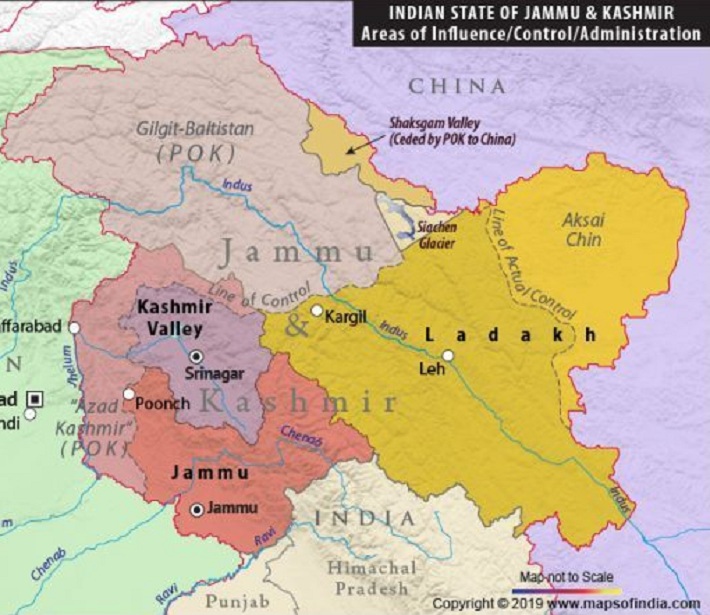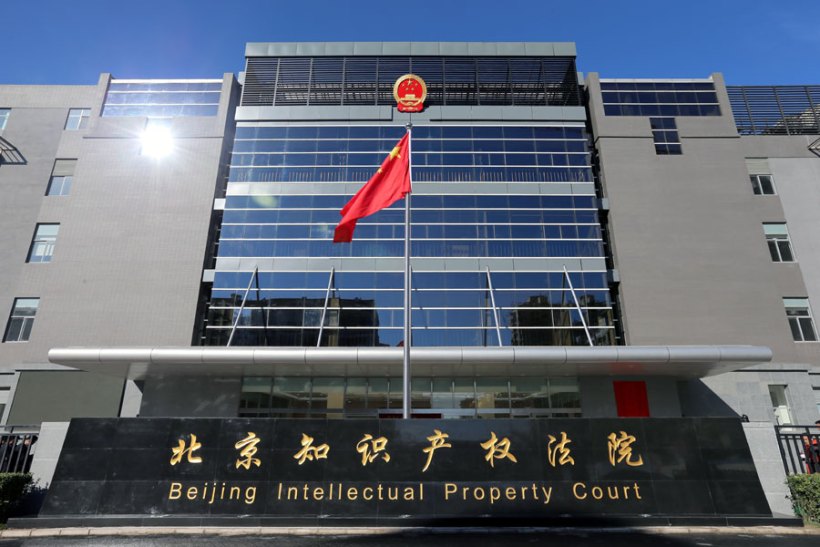Priyanka Madia, Research Intern, ICS
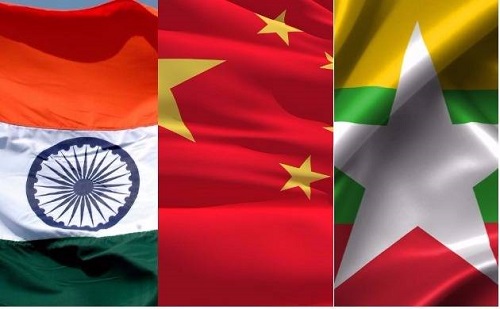
Myanmar is one of India’s most important neighbors, four of our sensitive Northeastern states share a border with Myanmar, and it is India’s land gateway to Southeast Asia. Myanmar is a country enriched with abundant natural resources with an economy complementary to India. India and Myanmar share a long land border of over 1600kms and a maritime boundary in the Bay of Bengal. India shares the strategically important ocean space of the Bay of Bengal with Myanmar. China’s dominant presence at the port of Myanmar, which gives open access to the Indian Ocean to China, could become a significant security concern for India. The blog argues that India must be far more focused on strengthening its relations with this neighbor than is evident today.
Myanmar is located on the eastern flank of India. It is shaped like a large kite, with a mountainous crescent to the north, alluvial plains at the center, and a long and narrow isthmus stretching into the Andaman Sea to the south. From east to west, it is watered by the Chindwin, Irrawaddy and Salween rivers all of which run north to south. This makes north-south communication links much more comfortable than the east-west links, which have to cross the deep river valleys and also the lines of hills. Myanmar is a multi-ethnic country. The 18 major ethnic groups occupy the rugged mountains on its borders with India, China, and Thailand, with the majority, the Burman population, inhabiting the flat plains at the center and along the coast. Myanmar has a history of ethnic conflict, which is a constant preoccupation for the central government. The ethnic groups also spill-over into neighboring countries, with India, for example, the Nagas and the Mizos (known as Chins in Myanmar) straddle the border. Just as the country enables access to Southeast Asia for India, it is also a corridor for China to the Bay of Bengal and a partial answer to its so-called Malacca Dilemma, or the need for most of its energy supplies and cargo from across the Indian Ocean to pass through the narrow confines of the Malacca Straits. Hence, Myanmar plays a crucial role in China’s ambitious Belt and Road Initiative(BRI).

Myanmar-China Relations
Throughout history, Myanmar has tried to balance its relations with its two giant neighbors, India, and China. However, Myanmar has had a higher threat perception from China because of the latter’s use of ethnic groups to keep the central government off-balance. This had continued though, in different forms, Chinese influence in Myanmar began to see a significant rise since the 1990s when the military junta staged a coup and prevented the democratically elected National League for Democracy(NLD), led by Aung San Suu Kyi from taking office. The military regime faced international criticism and sanctions. India, too, opposed the government and supported the National League for Democracy. China stepped in to help the Myanmar military with arms and economic and commercial links and soon became an essential partner. It assisted the regime by brokering arms for peace or ceasefire agreements with the various ethnic groups under its influence for several years. Despite the political changes that have taken place in Myanmar in recent years with Aung San Suu Kyi and her party sharing power with the deeply entrenched military, China has maintained enough levers of influence to continue its dominance country.
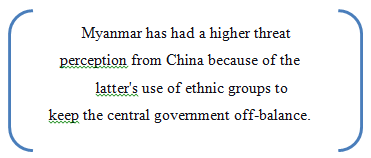
Myanmar has never been comfortable with its over-dependence on China. Even the military regime tried to balance Chinese influence by becoming a member of the ASEAN in 1997 and later of the BIMSTEC. It responded positively to India’s overtures in the 1990s and encouraged Indian support to infrastructure building, including cross-border links. Chinese involvement in infrastructure projects was slowed down, with the Myitsone hydro project suspension on the upper reaches of the Irrawaddy River. There was also a degree of caution in its participation in the BRI to avoid high debt levels. However, in other respects, China has probably emerged as an even more powerful influence in the country than a decade ago. Some of the key projects are the oil and gas pipeline from Myanmar’s Rakhine coast to Yunnan province, the development of the Kyaukphu deep water port, and the proposed rail and road links connect to Southeast Asia through Myanmar.
There are two significant projects between China and Myanmar in terms of the Belt and Road initiative. The Kyaukphyu special economic zone is one of China’s crucial projects at the Bay of Bengal coast on the western Rakhine state, giving China direct access to the Indian Ocean and allowing its oil imports to bypass the Strait of Malacca. It also serves the terminus for the twin cross border oil and gas pipelines between the two countries. The framework agreement was signed between the Myanmar government and the China International Trust and Investment Corporation (CITIC)in November 2018. The project investment in the initial phase was US$1.3 billion, with 70 per cent from CITIC and 30 per cent from the Myanmar government. The concession period is said to be 50 years, during which the Myanmar government will earn US$7.8 billion in revenue from the SEZ and US$6.5 billion from the deep seaports. The project covers a combined 1000 hectares, including an industrial park and deep seaports on Made and Yanbye islands.
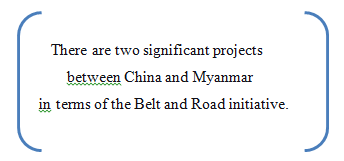
Muse Mandalay railway project travels from China’s Kunming through Myanmar’s Muse on the Chinese border in northern Shan state to Mandalay in Central Myanmar. It’s a part of Beijing’s plan to build a parallel expressway and railway line from Ruili (across the border from Muse in China’s Yunan province) to Kyakphyu. The 431kms electric railway passes through armed conflict areas in Shan state; the estimated investment cost is US$8.9 billion.
During President Xi Jinping’s two days, visit Myanmar on 17-18 January 2020, which was the first visit by a Chinese leader in 19 years. There were talks held, and dozens of agreements were signed, paving the way for implementing various projects underway the Belt and Road initiative. However, Myanmar is not a passive bystander and has managed to negotiate better conditions regarding BRI projects. In 2017, the CITIC group decided to reduce its stake in the project from 85 to 70 per cent. Also, the Myanmar government effectively scaled the project down from $7.3 billion to $1.3 billion in 2018, realizing that the project was taking on too much debt.
India-Myanmar Relations
Since the 1990s, it has been an objective of Indian policy to become a significant countervailing presence to China in Myanmar. This has been moved by the need to elicit Myanmar’s cooperation in dealing with the Northeast insurgencies and promote India’s Look East policy. There are two significant projects in Myanmar led by India, which focuses on improving connectivity with Myanmar and enable to counterbalance China’s BRI in the Indo Pacific region. Still, its efforts have paled in comparison to China.
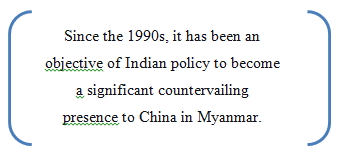
The India-Myanmar-Thailand highway project will boost trade and commerce in the ASEAN, India Free Trade Area, and the rest of Southeast Asia. It is a part of India’s Look East Policy that will cultivate and strengthen economic and strategic relations with the nations of Southeast Asian countries to solidify its standing as a regional power. The project helps the Indian position as a counterweight to the People’s Republic of China’s strategic influence in the region.
Kaladan Multi-Modal Transport Project is set to promote neighborly ties, trade, and tourism under the government’s Look-East or Act-East policy. But unfortunately, it hasn’t traveled much, the Kaladan Multi-Modal Transport Project is designed to connect Kolkata with Myanmar’s port of Sittwe by sea and to move northwards by the Kaladan river to Paletwa, and a long stretch of road from to Mizoram in India’s Northeast. This project is seeking an extension till June 2021. The fundamental goal of construction of Sittwe Port is to create a multi-modal sea, river, and road transport corridor for shipment of cargo from the eastern ports of India to Myanmar through Sittwe port and to the Northeastern part of India via Myanmar. The approved construction cost is US$68 million. But the projects are consistently facing delays.
India has failed to emerge as a credible countervailing power balancing China’s formidable presence in Myanmar. An entrenched Chinese presence along the Rakhine coast across the Bay of Bengal is particularly worrisome. With Nepal, Sri Lanka, Bangladesh, and Myanmar wading into the BRI, India stands badly isolated, and this is something India needs to work upon. Since 2012, India has been trying to modernize and extend its navy to counter China’s increasing challenge, but finances are scarce, and projects are yet to materialize. That makes it harder to maintain India’s ambition to become the Indian Ocean’s security provider.
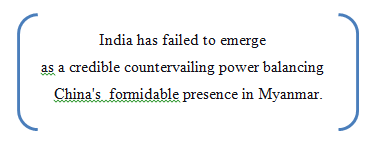
To knit the Indian Ocean into existing defense plans for the Pacific, India should coordinate with the Quad, including countries in the United States, Japan, and Australia. Myanmar is desperate for financing to help build roads, ports, power plants, and other massive infrastructure to drive economic growth. Since the world is well aware that Chinese loans come with a deadly debt trap, expanding China’s geopolitical and military reach and failure to be transparent creates a vast opportunity for India to compete with China and blunt some of its recent gains. India should be focusing on the project that helps the Indian position as a counterweight to the People’s Republic of China’s strategic influence in the region.

